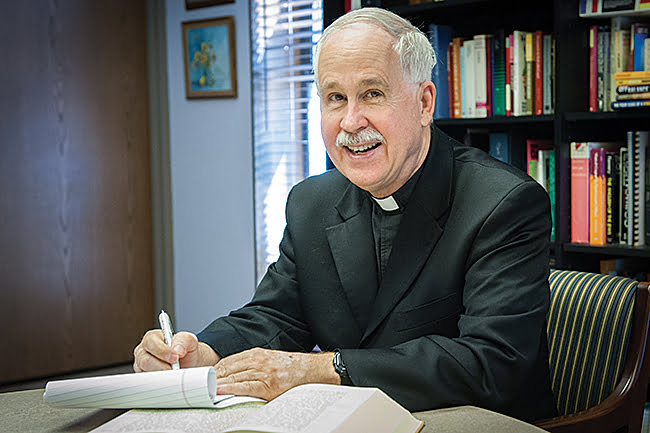
Father Mike Stubbs is the pastor of Holy Cross Parish in Overland Park and has a degree in Scripture from Harvard University.
by Father Mike Stubbs
Like a good teacher, the prophets of the Bible sometimes drew on visual aids to make a point.
For example, the prophet Jeremiah smashed a clay pot to pieces while saying: “Thus says the Lord of hosts: Thus will I smash this people and this city, as one smashes a clay pot so that it cannot be repaired” (Jer 19:11).
He got his point across.
Jesus also was a good teacher. We see him getting his point across by means of a visual aid in Sunday’s Gospel reading, Jn 2:13-25. While in the temple in Jerusalem, he drives out the livestock dealers and money-changers, and overturns their tables.
What is the message that Jesus is attempting to convey by this action? Is it merely a criticism of buying and selling in a religious arena, or is it something deeper?
It is entirely possible that Jesus was pointing to a complete overhaul of the temple, one that would require its destruction in order to make something new.
During his trial before the Sanhedrin, Jesus was accused of envisioning the destruction of the temple: “We heard him say, ‘I will destroy this temple made with hands’ and ‘Within three days I will build another not made with hands’” (Mk 14:58).
A temple not made by hands would be a temple made by God, instead of human beings.
This charge is later echoed when Stephen is brought before the Sanhedrin: “This man never stops saying things against this holy place and the law. For we have heard him claim that this Jesus the Nazorean will destroy this place and change the customs that Moses handed down to us” (Acts 6:13b- 14).
Both Jesus and Stephen are accused of plotting to destroy the temple, or at least talking about its destruction as necessary for its renewal. Significantly, that destruction does take place years later, in A.D. 70. The Romans demolish the temple in Jerusalem and destroy the entire city.
When that happens, the followers of Jesus do not seek to rebuild the temple. Instead, they decide to replace it with Jesus himself as their focus of worship.
It is through Jesus that they will encounter God from now on. They reinterpret his words about the temple’s destruction to refer to his death and resurrection as a metaphor, and not to the actual building.
This explains the editorial comment in Sunday’s Gospel: “But he was speaking about the temple of his body” (2:21).
In any case, Jesus’ criticism of the temple makes up one of the charges that lead to his death. But three days later, he rises to new life. He fulfills the words we hear in the Gospel: “Destroy this temple and in three days I will raise it up.”

